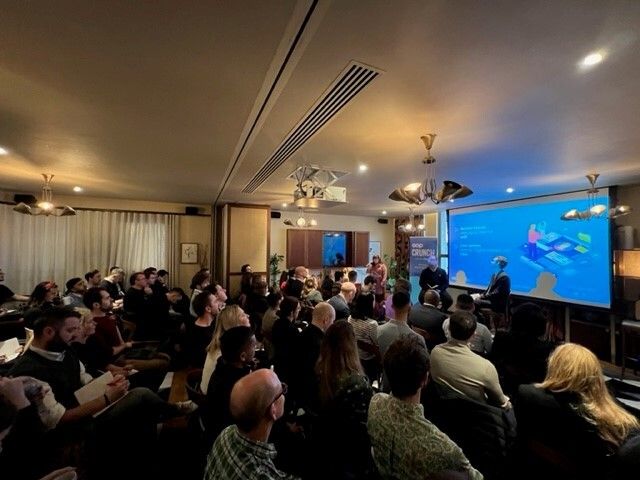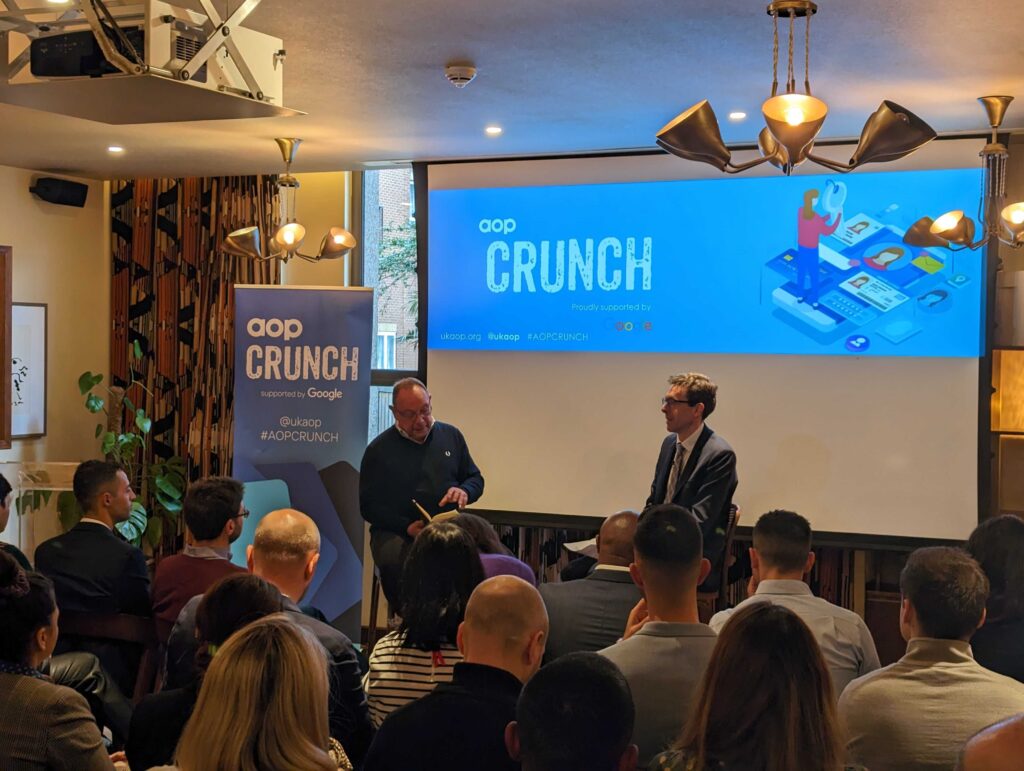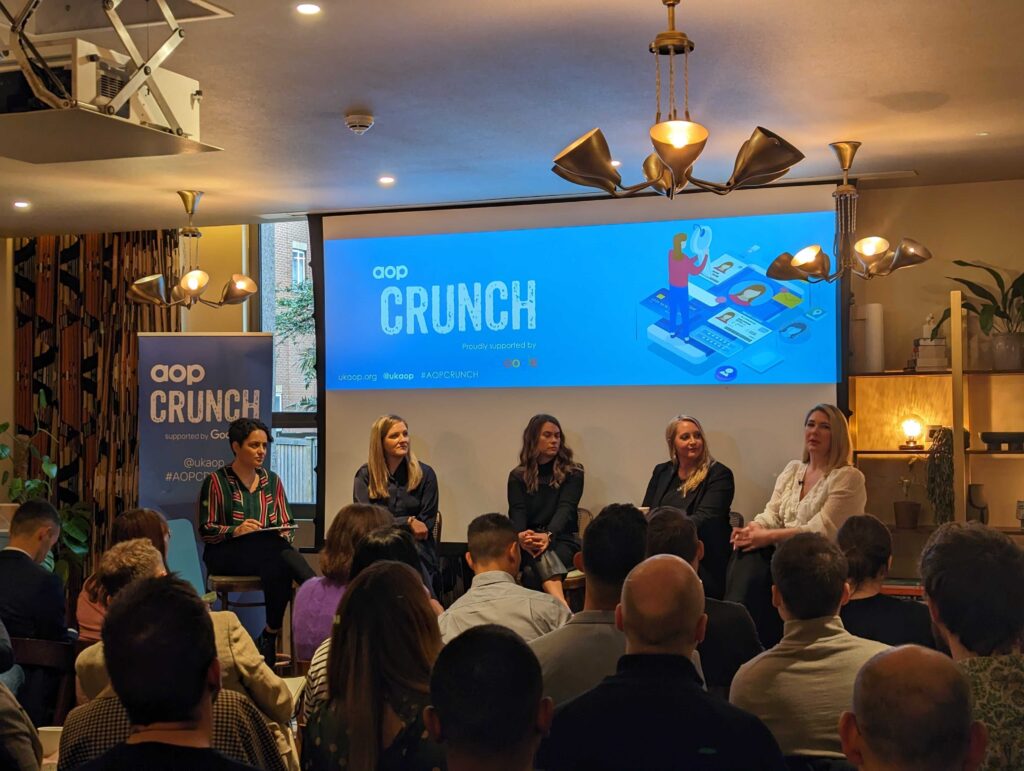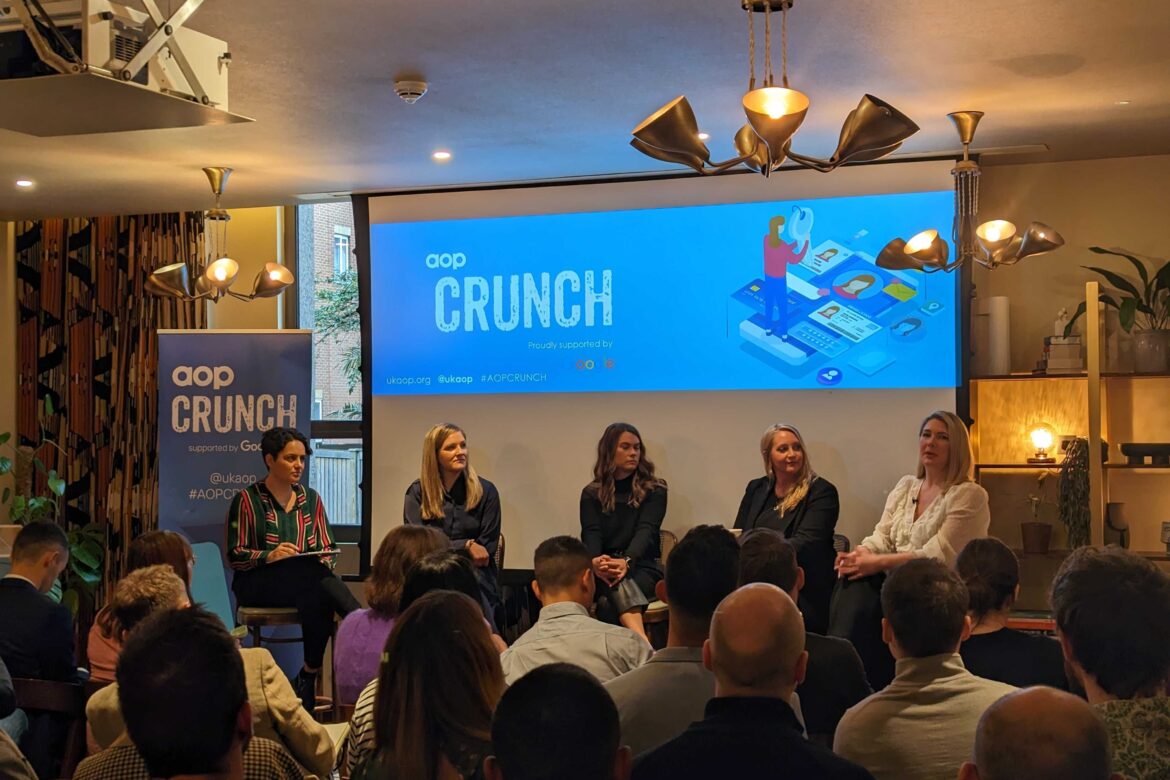|
Getting your Trinity Audio player ready...
|
The UK Association for Online Publishing (AOP) – the industry body representing digital publishers – held its first CRUNCH event of the year late last month in Hoxton, London. The event looked at demystifying identity, tackling common misunderstandings, and exploring the solutions available. Richard Reeves, AOP’s Managing Director, outlines the key takeaways…
Can you believe we’re still talking about cookie deprecation? The industry may have let out a collective groan when Google announced its latest delay, but in hindsight it has been a blessing. Mainly because fundamental questions remain unanswered around how publishers identify users on the open web, how they activate their data, and how they secure permission to do so in the first place.
This isn’t necessarily a bad thing. The reason there is no singular answer to identity is because there is no singular solution. Today, the ecosystem is bustling with competing and overlapping technologies and — as we found in our first CRUNCH event of the year — you won’t find a one-size-fits-all method for building and monetising audiences. Rather, there are a range of bespoke approaches fitted to the needs of the publisher, their readers, and advertising partners.
To gain as broad a perspective as possible on this ever-expanding topic, we invited regulators, publishers, vendors, and agencies to share their perspective on identity and the many forces that might affect its future course.




Regulators to impose conduct requirements on major players in the UK’s digital markets
In 2021, the Digital Markets Unit (DMU) was established within the Competition and Markets Authority (CMA) to tackle anti-competitive behaviours among the industry’s biggest players. Details of its new regulatory regime and the DMU’s powers to enforce it will be rubber stamped in the upcoming Digital Markets, Competition and Consumer Bill, which is soon to be presented to Parliament.
The genesis of the bill, according to Chris Jenkins, Director of the DMU, was the struggle competition authorities have faced around the world with slow-acting legislation; that which identifies and responds to problems that have already occurred, rather than establishing flexible controls that keep pace with rapidly evolving digital markets.
Central to this new regime will be the DMU’s ability to designate companies with significant and entrenched market power — the likes of Google, Meta, and Amazon — as having Strategic Market Status (SMS), at which point the DMU’s regulatory powers will kick in across three pillars.
Jenkins explains: “Once we’ve designated a firm as having SMS activities, we’d first impose conduct requirements – essentially, forward-looking principles of how the firm should operate. Secondly, we’d launch pro-competitive interventions, which would be triggered when we suspect there are features in the market that aren’t working well for competition.”
If we can then show there’s an adverse effect on competition, we’d impose quite wide-ranging remedies, including separation remedies in extreme cases. And the third is changes to the merger rules where SMS firms would have to notify us of all mergers.
Chris Jenkins, Director of the Digital Markets Unit (DMU)
An example of conduct that would trigger an intervention from the DMU would be if Google used data from Chrome in its ads business. Jenkins urged publishers to take part in the upcoming consultation process to determine SMS designation and conduct requirements, and recommended smaller publishers band together so their interests can be represented as well. Particularly as one of the conduct requirements will be that platforms won’t be able to discriminate in favour of large publishers over small.
Publishers are exploring a range of solutions to overcome the scale barriers of user data
Alex Wright, Programmatic & Platforms Leader at Channel 4, represents a publisher that — by the nature of its media and how its delivered — has never relied on third-party cookies for its targeting and is entirely focused on a first-party data strategy. Email addresses and four other data points are collected from its 29 million registered users through a mandatory log-in, in exchange for free access to Channel 4’s content.
To scale their first-party personal data, Wright’s team has gone all-in on cleanrooms, which allow brands to share their own first-party data to find overlapping audiences, which can then be activated across Channel 4’s platform. As there will inevitably be a high degree of drop off between the two data sets, the partner brand must have substantial scale of their own to begin with — a limitation Wright overcame by bringing more data into the fold.
“The brands we found that didn’t have scale were FMCG brands. I’m sure there are some exceptions to that, but as a rule, you don’t usually hand over your first-party data when you buy toothpaste …,” said Wright. “So, our first partnership was with Nectar360 … we’ve had fantastic attribution results as a result of that. That was an example of us going, ‘Hey, the brand doesn’t have the data, but who does? And how can we get into partnership with them?’”
Mia Mulch, Programmatic & Data Director at DAX Global, works in a similarly cookie-light environment, as much of Global’s radio content is played through smart speakers, resulting in a large non-addressable audience. One of Global’s strategies to increase addressability has been to incentivise users to link their Global Player account to their smart speaker, through functionality such as being able to comment on a radio station’s broadcast.
To further fill the addressability gap, Global took inspiration from its out-of-home business, where the lack of one-to-one access to consumers necessitated amalgamating multiple data sources into addressable models: “DAX Audiences takes all of the known, consented information we get from our users — obtained from our own proprietary tech stack, including the SSP and the ad server — and then models it out to create profiles across our non-addressable smart speaker inventory. And we’ve increased that ability to have an addressable audience by tenfold on those non-addressable spaces.”
For Hannah Buitekant, Managing Director, Digital, at dmg media, the challenge is the sheer scale of the brands she oversees. The dmg media portfolio includes MailOnline, Metro, and inews, none of which have mandatory logins to access content, so targeting profiles are built from a mix of authenticated, directly identifiable data shared by known users and pseudonymous data collected from the various touch points that unknown users interact with.
Next, standardised cohorts and segments are created that can be universally traded against, which Buitekant hopes will become interoperable not just across dmg media’s own domains but across the industry. However, the segmented and siloed approach taken by different advertising partners has made the pursuit of interoperability almost impossibly complex.
One partner uses Google infrastructure, another uses LiveRamp infrastructure, and another uses ID5 infrastructure, and so on. Ultimately, we have 20-plus proof of concepts out there that we’re working on … The whole time, you have to have one-to-one conversations with the advertiser who brought that technology to the field. And if it doesn’t work, they turn it off really quickly, and leave you there dancing alone.
Hannah Buitekant, Managing Director, Digital, at dmg media,
The Financial Times runs a 100% direct advertising model and has pursued a “build internally” approach to its tech for many years. Katrina Broster, the company’s Marketing Performance & Technology Director, has been exploring how to enrich registered users and subscriber profiles in preparation for cookie deprecation. This includes collection of demographic data, which she sees as The Financial Times’ core competitive advantage, supporting multiple commercial outcomes across the business.
To allow all business units to benefit from user data, The Financial Times has established workstreams dedicated to data standardisation and has established strict criteria for what counts as a “recognised user”; a known user who declares demographic data and provides consent to be marketed and advertised to. This approach provides marketers with access to prospective customer data whilst ensuring that advertisers receive the most accurate and valuable insights possible and has led — unusually for the company — to the FT exploring partnerships with third-party vendors to provide data clean room technologies and customer data platforms.
“[Audience] scale is of huge importance to us but the negative side of scale is potential deterioration in accuracy and relevancy. Our buy-side activity may struggle to generate audience groups big enough to match with some of the big media platforms,” said Broster. “So, we’re always in this conundrum of whether we aggregate that data to get the scale we need to enable the matching off platform versus a focus on the need to find alternative methods of targeting and engaging with our users, preferably utilising our own real estate, rather than relying on Google, Meta, etc.”
We’re in a kind of weird funk at the moment, and will continue to explore all options available to us to ensure we’re spending our marketing budgets in the right places.
Katrina Broster, Marketing Performance & Technology Director, Financial Times
Vendors want to see publishers test and learn, and unlock revenues along the way
Publishers should be testing a wide variety of identity solutions, according to Kofi Amoako, EMEA Vice President of Addressability at PubMatic. By integrating multiple IDs and then disabling them one at a time, publishers can isolate their effects and build a portfolio of the best performers, with Amoako seeing significant uplift when three or four identity partners are in the mix.
Those who don’t aren’t just missing out on testing opportunities, they’re leaving money on the table: “Use what’s available right now. There’s incremental revenue … Where we’ve seen identities present, in every instance, we’ve seen revenue uplift of anything between 1% upwards of 4%, and we can only see that improving over time. So yes, you might turn around and say, that’s not ground-breaking. But at the same time, while you’re going through this testing stage, why not pick up the incremental revenue?”
In this final stretch before the cookie deadline, Joanna Burton, Chief Strategy Officer at ID5, recommends publishers use the time to review their data sources and remove any remaining third-party cookies to test alternatives. Safari and Firefox provide environments for publishers to experiment in an environment which does not support third-party cookies by default while more effectively monetising inventory that — despite accounting for around half of traffic in some instances — has historically been underutilised in favour of Chrome.
Burton also suggests publishers look beyond building identity off of email addresses and layer in other sources and solutions such as seller-defined audiences, third-party audience data, IP addresses and so on. Though she added that part of the problem is advertisers often get stuck on wanting to activate their email addresses and mobile IDs on the open web, which limits their targeting of people they already know and treats publisher audiences as mere email lists.
Mattia Fosci, Founder and CEO of Anonymised and host of the panel, noted that he had encountered scepticism from publishers over solutions that replicate third-party cookies: “We’re taking for granted that creating those connections between different audiences is a good thing. But many publishers I spoke to told me, ‘We don’t think third-party cookies worked for us very well, because our audiences became a bit of a commodity and therefore were depreciated.’ So many are looking at ring fencing their audience data a little bit more and investing in third-party solutions.”
Reza Amiri-Garroussi, UK Head of Addressability at LiveRamp, has reassuring news for publishers worried about ad spend being funnelled into walled gardens. A study conducted by LiveRamp and Censuswide found 72% of advertisers in the UK intend to increase their spend on the open web. To take advantage of this demand, Amiri-Garroussi urged publishers to focus their efforts on surfacing the addressable audiences and enriching every bid request passed up and downstream.
We are seeing increased density in bid requests enriched with some form of identity solution. That’s a fact. We know SSPs throttle back inventory based on the scale they receive and the kind of enrichment they’re seeing through that bid request. So, inventory enriched with some form of ID is seeing higher bid density and more opportunities for DSPs to bid on your inventory, and subsequently increase yield.
Reza Amiri-Garroussi, UK Head of Addressability, LiveRamp
For James Rosewell, Founder and CEO at 51Degrees, the dream is to see decentralised, open-source technology fill the gap left by third-party cookies: “Rather than perhaps looking at solutions, why not look at protocols? We have email, it’s one of the most enduring protocols that’s ever been invented in the digital market. It’s completely decentralised; no company dominates it (or charges excessive prices). Why not use this opportunity — a once in a lifetime opportunity — to introduce something that’s going to be a major change to publishing and put publishers in control?”
Rosewell pointed to the Secure Web Addressability Network (SWAN) — an interoperable, transparent identifier and consent mechanism on which Rosewell is a contributor — as an example of a decentralised, easy to understand, open-source solution developed to provide utility for the open web and enhance publishers’ understanding of their entire supply chain.
Agencies need to see better measurement from publishers to win over ROI-focused clients
Morys Ireland, Head of Data and Technology Services at Mindshare UK, has seen his clients get a lot closer to their first-party data in the post-GDPR ecosystem, and increased interest in technologies that enable this data to be shared securely – from clean rooms to data meshes. However, the simplest option is often to turn to bigger platforms that have fully-fledged solutions around using first-party data and activating it in media.
For Ireland, measurement is key to attracting advertiser spend to the open web: “Early on in the whole post-cookie thing which all kicked off in 2020, I think the focus was largely on how we replace audience targeting. Increasingly, what we’ve been finding is it’s all very well if you can replace audience targeting, but if you have no idea how that’s working, then that’s a bit of a problem. So, measurement is certainly a big focus for us.”
Sherrick Chavda, EMEA Group Director of Audience & Data Strategy at Initiative, echoed Ireland’s sentiments: “We’ve been in awkward conversations with clients, trying to present these wonderful solutions that publishers are bringing to us on a daily basis and, at the end of the day, it just comes down to return on investment. And if we can’t prove that, then we don’t really have a leg to stand on.”
But Chavda is optimistic that publishers are getting better at proving the value of their audiences and being more transparent about how they are created, thanks in part to solutions such as seller-defined audiences. Chavda advised that publishers demonstrate the care they put into capturing every single data point and communicate that within the wider data privacy narrative in order to secure their spot on media plans.
Luke Pay, Director of Data & Tech Consulting at Publicis Media, commented: “It isn’t just about measurement [of cookie deprecation impact], it’s sequential measurement, dynamic content optimisation, behavioural targeting, demographic targeting — all those things require cookies at some point. So, we need to test all these newer vendors that do this and find out the problems with them … We need to collaborate to understand what is, what’s not, and what’s definitely not possible. Multi-touch attribution is probably never going to come back, it’s never going to be as good as it was.”
Despite the complications of the post-cookie ecosystem, Pay feels positive about its overall health. The diverse array of vendors developing solutions has fuelled the competition and innovation necessary for technological breakthroughs to emerge, while walled gardens are “taking a hammering” from the increasing prominence of other media channels vying for ad spend – from TikTok and CTV, to retail media networks and, of course, publishers. Pay noted that, in the US, Google and Meta’s share of ad spend has dropped below 50% for the first time since 2014.
Whether the era of walled garden dominance is coming to an end, or the balance of power is merely changing hands to rising big tech giants in retail media and AI, it’s clear that all stakeholders in the open web must continue to educate each other on what works in a post-cookie, post-GDPR, privacy-first ecosystem.
Richard Reeves
Managing Director, AOP
The UK Association for Online Publishing (AOP) is an industry body representing digital publishing companies that create original, branded, quality content. AOP champions the interests of media owners from diverse backgrounds including newspaper and magazine publishing, TV and radio broadcasting, and pure online media.


